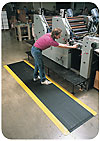
Installing anti-fatigue matting in your workplace to improve work conditions seems, on the surface, like a pretty simple endeavor. Surprisingly, however, many companies use the wrong products for their applications.
When the correct matting product is chosen for a specific application and the proper configuration is installed, anti-fatigue matting and ergonomic flooring function efficiently and effectively to increase the productivity of standing workers. Before investing in these types of products, consider the following suggestions so you can make the most of your anti-fatigue flooring solution.
Know the work area
First of all, mats must match the configuration, size and workflow of the area. Understanding the workflow is especially important. For optimum productivity, employees must remain focused on the job, not on the environment. Ideally, the employee should always be on a level surface so he is not preoccupied with stepping off of or onto the mat. If workers simply stand at individual workstations and rarely move around during their shift, then stock size mats are often all a company needs.However, many employees must walk from place to place in order to complete a function. Some mats can be interlocked together to create long runs. This is especially important for extended assembly line applications where workers walk back and forth from one task to another. But this is simply the most basic of customized applications. In recent years, there has been more of an emphasis on designing mats to “wrap around workstations.†This entails custom cutting and seaming, and results in matting that perfectly fits the work pattern and increases employee safety.
An example of customizable matting is modular tile. If part of your work area is wet or greasy and part of it is dry, choose modular matting that is available with and without a gritted surface, using the gritted tiles only where needed. By specifying the exact areas where grit needs to be adhered to the mat, you reduce costs.
Modular tile matting can also accommodate difficult angles and can be available in several durometers — use harder tiles for areas with heavy cart or equipment access and softer tiles where employees stand for longer periods of time.
Floor above a floor
In forward-thinking plant environments, it is becoming increasingly common to see the creation of an ergonomic floor above a floor. Often these flooring systems are permanently installed for ease of maintenance. Some products actually have countersunk holes to accommodate anchor bolts so that the edging can be permanently installed. This eliminates any movement of the mat. (Regardless of their weight or gripping power, mats have a tendency to move because of the forward inertia of humans stepping on them). Another benefit is that damaged areas can be replaced without incurring the cost of replacing the entire anti-fatigue system.If installing ergonomic flooring is an option for you, keep in mind that the smaller the individual modular tile or mat, the longer and more costly the initial installation. Also, make sure that the product will withstand all the rigors of the environment, from cart traffic to industrial fluids. If possible, mix and match mats with identical formats and different compounds to fit the needs of the environment.
Heavy traffic
An example of companies purchasing the wrong mat for the application involves mats with pronounced surface designs for use in areas with cart traffic. This creates more work and dangerous stress on wrist joints. Durable ergonomic flooring products with a relatively high durometer (70 to 80) accommodate cart traffic. They also must have surface designs that do not impede wheels and withstand the weight of heavy loads. This allows the carts to be within reach of the employee, resulting in increased worker productivity.Fluids and chemicals
Finally, the most prevalent issue is that companies choose the wrong mat for the fluids and chemicals in the environment. Industrial greases and oils are often petroleum based. The best compound is Nitrile rubber. Always check with the manufacturer of the matting product to make sure that your chemical will work with the mat you’ve chosen. If there is not a definitive answer, ask for a free sample and test it yourself. Otherwise you will be replacing your mats much more quickly than necessary and possibly putting your employees in a less-than-safe situation.Save money
If you choose the proper mat for the application, early replacement is not an issue. This saves money and down time. Consider size, configuration, functionality, comfort and chemical resistance when evaluating your space and needs.Despite your best planning, over time small portions of the mats will be damaged. Many custom mats are modular, which allows individual sections to be easily replaced without exchanging the entire mat. Modular and customized mats that perfectly fit the flow of traffic are a necessity in maintaining productive plant operations.